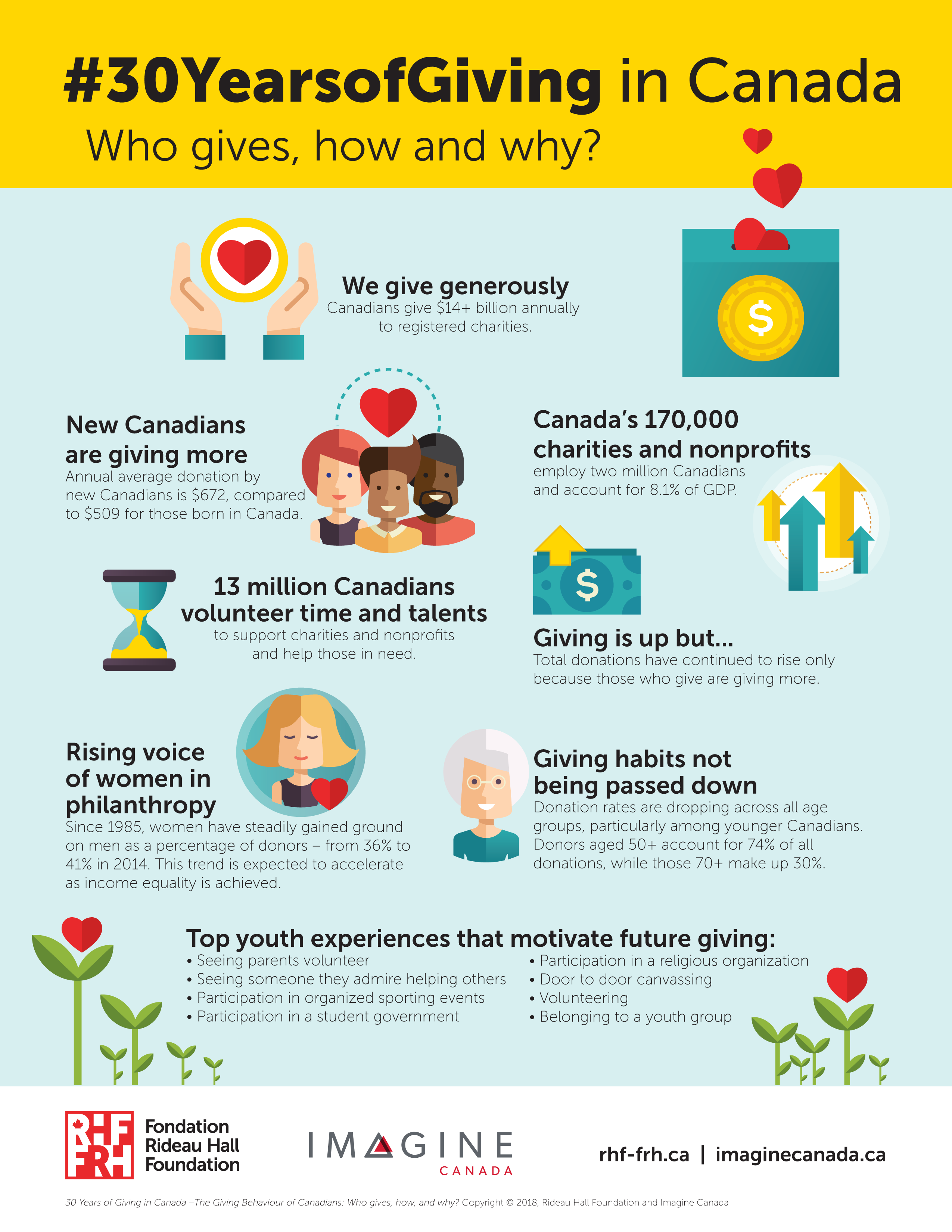Charities are a key part of our society and our economy. They are integral to our conception of what being Canadian means.
In every community across the country, they deliver health, education and social services; they cater to our cultural, recreational and spiritual needs; and they work to protect animals and our natural environment.
They provide opportunities for personal growth and community engagement; they offer established and regulated ways to fulfill our philanthropic goals; and they employ a significant proportion of the population. Although the money charities use to fulfill their missions comes from many sources – including government, business, and the sale of goods and services – almost all organizations rely to some extent on donations from individual Canadians.
In our new report for the Rideau Hall Foundation, 30 Years of Giving in Canada: Who gives, how, and why?, we draw on a number of different data sources to present a detailed and comprehensive picture of charitable donations in Canada and the giving behaviours of individual Canadians.
Here's a helpful infographic which you can download and share with your online community.

How generous are Canadians?
We estimate that individual Canadians gave approximately $14.3 billion in receipted and unreceipted donations to registered charities in 2014. Claimed donations have increased 150% in real terms since 1985. However, the proportion of taxfilers claiming donations has been falling steadily since 1990, which means charities are relying on an ever-smaller proportion of the population for donations. Total donations have continued to rise only because those who give are giving more. Recent research comparing levels of charitable giving in several countries found that Canada has the third highest level of giving, following the United States and New Zealand.
What causes do Canadians support?
Canadians support charities working in a wide variety of areas. However, more than three quarters of all donated dollars go to the “big four” causes: Religion, Health, Social Services and International. Giving to Religious organizations is decreasing, but still accounts for the largest portion of donations. Large proportions of the population give to Health and Social Services organizations, but the amounts given are low compared to Religion. Giving to International causes is increasing, both in terms of the amounts donated and the number of Canadians donating.
How do generational shifts affect the giving landscape?
The Baby Boom generation (1946 to 1965) has been the most important component of the donor pool for the past 30 years and is responsible for more than 40% of total donations since 2000. However, the peak donation rate of Boomers was lower than the peak donation rates of earlier generations and it appears the peak donation rates of Gen X and Gen Y will be even lower. The giving habits of Gen Y are particularly worrisome. Both the donation rates and average donations of this group are low and increasing very slowly. On a more positive note, younger Canadians are less likely than older Canadians to express negative views about charities.
What are the trends relating to gender and income?
Charities have always relied heavily on donations from those who are in the best position, financially, to give. Historically, this meant that wealthy males dominated the donor pool. There is evidence this has changed somewhat over the past thirty years. Men continue to be more likely to claim donations and to donate more, but women now represent a larger percentage of the donor pool and a greater proportion of the money donated than they did in the 1980s. This is expected to accelerate as income equality is achieved.
Over the same period, however, Canadian charities have become more dependent on affluent Canadians. In 1985, the top 1% of taxfilers (then earning $80,000 and up) accounted for only 16% of donations. In 2014, the top 1% (those earning $250,000 and up) accounted for 31% of donations.
How do new Canadians give?
Immigrants to Canada are much more likely to give to Religious organizations than are those born in Canada and they give a larger proportion of the money they donate to these organizations. They are almost twice as likely to say they donate because of religious obligations. Immigrants are also more likely to say they didn’t know where to give or couldn’t find a cause worth supporting, and they are more concerned about charity fraud or scams. There is potential here for charities to reach out more to new Canadians, and work to instill trust.
How do Canadians learn about giving?
Giving is a learned behaviour. Canadians who participate in community-oriented activities when they are young or observe people they admire helping others, are more likely to donate as adults. They also tend to donate more. These pro-social activities include participating in religious organizations, youth groups, student government, organized sports, door-to-door canvassing, and volunteering.
What's our analysis?
The findings presented in 30 Years of Giving in Canada suggest that, despite the unquestionable generosity of Canadians, much could be done to increase giving in this country. Finding ways to more effectively engage young people and new Canadians would be particularly beneficial. The expansion of formal efforts to teach young people about giving, in both secondary schools and in colleges and universities, would be one way to do this. Efforts to encourage well-off Canadians to dig a bit deeper would also be useful. Finally, charities would likely reap significant rewards from finding ways to more effectively engage immigrants to this country. Even small increases in the proportion of Canadians who give and/or small increases in average donation amounts would have an enormous impact.
Time is of the essence, however. The Boomer generation, which has been the mainstay of the charitable sector for most of the past 30 years, is aging. There is a limited amount of time left to tap into the philanthropic impulses of this generation and it is unclear if younger generations will be willing or able to take their place. The evidence suggests this will be a challenge, but it is not a lost cause. Although they give less than earlier generations, young Canadians do have generally positive attitudes towards charities.
This is both a challenge and an opportunity for the sector. Organizations that are adept at understanding changing attitudes and preferences will be in a better position to adapt their messages and tactics. To navigate this uncertain future, the sector will need more and better data and strong digital strategies to facilitate future giving. Collective efforts to encourage a more robust giving culture are crucial to sustainability.



